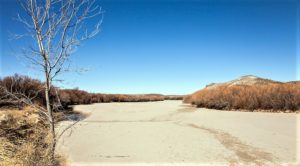Although not an exact quote, that line from Samuel Taylor Coleridge’s 1798 poem the Ancient Mariner is becoming increasingly true at a time when most freshwater is used to produce food.
As you’ve probably read ad nauseum, global population estimates point to having nearly 10 billion people by 2050. As much food needs to be produced in the next 40 years as the past 10,000 combined and crop production will need to increase by 70%. In a round-about way, that’s good news for farmland investors because we’re growing food to meet the burgeoning demand, but it also places a heavy burden on all farm operations to conserve water as it becomes more and more scarce.
“Brian – how can water be scarce? After all, 71% of the Earth’s surface is covered in water, right? And we live in a closed system; it’s not like water can just drift off into the rest of the universe.” Well, the first problem is that only 3% of that water is fresh and the rest is saltwater. Second, 70% of water in developed countries and 90% in developing countries is used for irrigation.
Add to that the UN Food and Agriculture Organization forecast that by 2050 global water requirements for agriculture will increase by 50% to meet the increased food demands of a growing population. Clearly, sustainable use of this precious resource is critical if we are going to feed the planet and have enough drinking water.
Whiskey Is for drinking; Water Is for Fighting
Another quote, often attributed to Mark Twain, is that “whiskey is for drinking; water is for fighting.” Indeed, water wars in the western U.S. took place all too frequently in years past and water continues to stoke the fires of international disputes worldwide. The point is that water isn’t just important… it’s so critical for civilization to continue that it’s worth fighting for.
A big part of the growing water problem is that we don’t have the water where we need it. Major cities across the world are or will be experiencing serious water shortages; reservoirs, wells and rivers are drying up or have become contaminated. A few years ago, the BBC wrote about how Cape Town, São Paulo, Bangalore, Beijing, Cairo, Jakarta, Moscow, Istanbul, Mexico City, London, Tokyo and Miami are all facing a serious water crisis.
I dare say that is not a comprehensive list and you can blame much of that on poor urban planning. Seriously, how the heck do you allow continued expansion and building when you know there won’t be enough water to go around? Of course, industrialization and climate change are also having their impact.
We are literally watching rivers disappear. In the U.S., the Rio Grande and the Colorado rivers are excellent examples. The Rio Grande forms part of the international border between Mexico and the U.S. but extends up through New Mexico and into the heart of Colorado. It stops flowing every year once the spring rains and melting mountain snowpack have ceased. The Colorado River is so over-allocated that it now routinely runs dry before getting to the Pacific. Both rivers are reduced to strips of sandy dirt like an African wadi.
In China, over 28,000 rivers have simply ceased to exist over the last half-century as overpopulation, deforestation, explosive economic development and climate change have all taken a toll on the river system. Ma Jun, director of the Beijing-based Institute of Public and Environmental Affairs, says, “At the moment, pollution discharge is destroying the limited clean resources we have.”

OK… Now That You’ve Got Me Worried, What’s the Answer?
There’s not much we can do about stupidity in government, but as individual investors, we can certainly put our money where changes are already being implemented.
As I’ve said many times, water is probably the most important ingredient for agriculture. The best land in the world without an adequate source of clean water is nearly useless. When I look for new projects the first question I ask is, “What is the quantity and quality of the water?” If there isn’t enough water to make it through drought conditions, I’m not interested. Or if the project doesn’t have full legal access to the water, I’m not interested.
At the same time, I’m very interested in what they are doing to minimize water usage. Flood irrigation is used worldwide. It’s an ancient, cheap and simple technology, and also wastes enormous amounts of water. All of the companies I represent use a form of drip irrigation that puts the water where it is needed and avoids the evaporation problem created by ditch or sprinkler irrigation.
Farmers in California find themselves in a difficult situation. Many own thousands of acres of land but no longer have access to adequate water to grow their crops. On top of that, improper irrigation methods have left the land in poor condition. No water and lousy soil. That’s not where I want to put my money.
Technology is the future
In the age of the internet, self-driving cars and deliveries by drone, there is hardly a single sector of the economy that isn’t driven by advancements in technology. If you’re not employing the latest technology in your particular industry, you’re lagging behind your competitors and probably leaving money on the table. Agriculture is no different. In fact, given the dire need for more food sources, leveraging technology is absolutely critical to the success of farming, especially when it comes to conserving water.
Greenhouses and the use of smart technology to make drip irrigation even more efficient are definitely the future of agriculture. Greenhouses take excess water and re-cycle it so there is no waste. Several of the farmland opportunities presented by Alternative Ag Investors have implemented a state-of-the-art drip irrigation system that employs sophisticated plant, soil and environmental sensing technology combined with cloud computing and artificial intelligence algorithms to provide precise, automated irrigation. This enables a real-time response to each plant’s individual needs.


